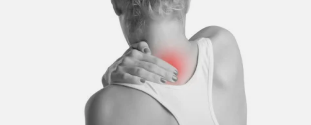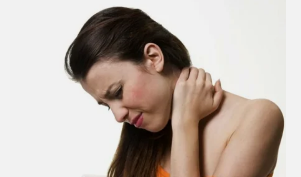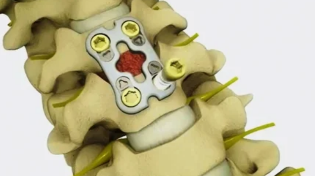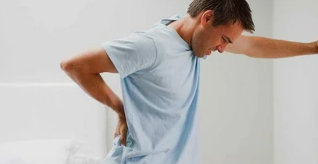Sick cervical osteochondrosis should know how to remove the deterioration.

Treatment during exacerbation of degenerative disc disease takes place under the supervision of a physician, compliance with appointments. At the time of the exacerbation, the doctor will recommend to terminate the sport. Permitted swimming with the proviso that after the pool ill dressed warmly
It is important, supercool. With the heat it is worth it to be careful
Soothe the pain the supine position on the side with toned knees. Possession of your body, helps to stretching the spine, releasing the disadvantaged nerve. When focus cannot be used massage. Possible light stroking using pain medication, ointments, gels. After handling with sick place worth wrap, put the patient to sleep.
During exacerbation of degenerative disc disease lasts 3 – 5 days. Depends on the severity of the disease, the number of patients the vertebrae, the patient's age, compliance with doctor's recommendations. After remission of the pain, it is worth it to start move. But gradually, not supercool.
Why make the disease worse
It should be noted that the sharpening process does not depend on the phase, it can occur on any of them, from the first to the last. Deterioration always precedes cause. Their basic list looks like this.
- The patient made a sudden movement.
- On the cervical zone provided with excessive load.
- Happened lifting weights, helena, their longer move.
- The patient is in a state of stress helena situation, when he's nervous.
- Made is not an expert on massage. Either the specialist didn't know about the presence of the patient degenerative disc disease, because he warned him.
- Are the observed sharp fluctuations of the weather.
- The patient received hypothermia all over your body helena zastudil cervical zone.
- After bath helena saunas the patient dipped in the hole of helena just cold water.
- The age of the patient is significant, to which the intervertebral disks, deleted and damaged due to the age of the split ends.
If you do not treat osteochondrosis, in what stage it was, the deterioration will arise necessarily previously helena later. Symptoms of acute degenerative disc disease of the neck it is necessary to know and well remember the resolution from the symptoms of other diseases of vertebrates.
Symptoms of exacerbation

The brightness of the severity of symptoms depends on the stage-language pathologists and the degree of its progress.
Their list is as follows.
- Pain in the crown area.
- Reduction of the cutaneous sensitivity of the parietal area.
- Pain on one side of the neck.
- Feelings of pain in the collarbone and shoulder.
- The severity of the language.
- Irregular breathing, it is not smooth.
- Soreness in cardiac region.
- The pain manifesting in the right hypochondrium.
- Headaches with pressure on the eyes, either unilateral headaches are just a part.
- Crisp, who is heard in the throat zone in the back in the implementation of the tilt, nod your head, helena his rotation.
- Fog in the eyes, spots helena points, hearing disorders and ringing in the ear.
- Soreness and weakening of the muscles in the hands, up to the brush.
To data symptoms of hard not to pay attention to, and yet there are patients who, even in a difficult situation are in no hurry to see a doctor, and try to help yourself home remedies
Diet
In the task of diet in osteochondrosis includes:
- normalization of metabolic processes;
- notice salt deposits in the spine;
- restore broken cartilage patterns;
- strengthening of the ligaments of the intervertebral disc;
- reduction of excess weight and obesity prevention. It is known that being overweight increases the load on the spine and causes the development of degenerative disc disease, so patients with this disease often diagnosed with obesity.
The diet should vote by the attending physician depending on the presence/absence of associated disease. Uniform diet in osteochondrosis not.
What products should enter into the menu is necessary to:
- dairy products (whole milk and dairy products);
- vegetable dishes, fresh herbs. Special emphasis should be paid to cabbage, cucumbers, radishes, stanislaus celery, beets;
- fruits and berries foods, including jellies and compotes;
- vegetable oils;
- low-fat meat;
- the flood of food, jelly;
- dark kinds of bread, biscuits, muffins;
- eggs;
- nuts, sunflower seeds, sesame seed;
- cereals;
- seafood (fish, shrimp, sea kale, mussels);
- still water.
In the diet diet in osteochondrosis of the spine should be excluded:
- fatty concentrated broths,
- fatty red meat,
- refractory animal fats, poultry (duck, goose),
- coffee and beverages containing caffeine (strong tea, chocolate).
Limited consumption of sugary foods and alkogolsoderzhaschih drinks.
Causes and symptoms of exacerbation of cervical degenerative disc disease
Osteochondrosis — the pathology of the vertebrae of the skeleton. Arise during the disorders of the intervertebral disc degenerative and degenerative character. The deviation has an effect on the tissue of the vertebrae, circulatory disease.
- VBN against the background of cervical degenerative disc disease: treatment
- Acupuncture in osteochondrosis of the cervical
The average age of disease onset is from 30 to 35 years. Due to the incorrect distribution of the load on the spine and feet, helena due to traumatic injury of the deviation can be diagnosed much earlier.
The main symptoms confirming the development exacerbations of the disease:
- Painful feelings, because in the hands, shoulders, regularly comes helena a constant feeling of tension in the back and neck area.
- The negative dynamics of the degenerative disc disease is accompanied by atrophic phenomena in the tissues of the muscles, the fluctuation of sensitivity, the variations in the work of the organs due to squeezing and bias.
- Pain in the head, dizziness, frequent fatigue, unpleasant sensations in the hands.
- Stiffness of movements, inability to sail, turns, triggered by numbness of limbs, pain in muscles and joints, cramps, hypotension.
- Flies and spots in eyes, noise in the ears.
Is not defined, timely treatment of cervical degenerative disc disease may go into a phase with heavy aggravations. Treatment in this stage should be carried out by a doctor.
The causes of deviations in the spine:
- Bad gain weight, it is spinal plague — socks bags, carry-on bags still on one shoulder helena in one hand.
- Twisted holding your body in a sitting mode.
- Too soft mattress and high pillow to sleep.
- Wearing the wrong shoes to the anatomical structure, narrow, oppressive, high heels, causing strain in the muscles and the worsening of the disease spine, degenerative disc disease of the neck part.
- Lack of exercise, being overweight, traumatic damage to the parts of the back, legs, flat feet.
- Age-related degeneration processes due to defective blood supply to the spine.
- Physical overwork, the crisis of the neuro-emotional system.
- Disorders of metabolism, diseases of stomach, intestines, accompanied by defective better assimilation of nutrients and useful substances.
- Dangerous occupations, work in locations with strong vibration.
- The presence of a genetic predisposition to a cervical osteochondrosis with aggravations.
- Failure to comply with the rules of the healthy posture of your body during the period of active growth, it is scoliosis.
- Dehydration of the body after a long period of time. Irregular, unbalanced diet, lack of the vitamin complex.
- The shift of the center of the load, arising in the course of pregnancy, the undeveloped muscular frame.
Deterioration caused by the seasonal influence, a way of life, can occur in unspecified time.
Treatment

To make it correct and comprehensive treatment is necessary to turn to the doctor. He will prescribe effective investigation to find the cause of the disease. Prescribe medicines, massage, therapeutic gymnastics.
When sharpening prescribed the following medications:
- anesthetic;
- chondroprotectors apply for a long time and for it to restore the cartilage of the fabric;
- relax the muscles, help eliminate muscle cramps;
- substances used medicine;
- vasodilators;
- vitamins D.
Treatments can be performed both at home and hospital. All depends on how strong the symptoms and what complications. To solve this will be just the specialist. Your doctor may send on the spot massage and so on. If not follow the recommendations of an expert, it will lead to serious consequences.
You need to include in your diet dairy products, lean meat, fresh fruits and vegetables, nuts, cereals, fish.
Special attention should be paid to the food, which contains jelly, it is the most commonly jelly. Olive oil need to consume dressings.
It is best to eat such food which will be prepared steamed, boiled and baked. Give up the salty, sharp, fatty, smoked products. Forbidden to drink strong coffee, tea, and leave the carbonated sweet water.

Massage well to help remove muscle tension and normalize the blood flow. But it is worth it in period of worsening degenerative disc disease to do it very gently and carried it must be only a professional masseur.
If the patient observed the strong feelings of pain, then you will need to comply with bed rest. There are cases that the patient is forbidden to get up this morning. But it may take no more than three weeks, because the muscles can atrophy. If a person felt an improvement, then you can get up, but a maximum of ten minutes a day. You must do everything so as the saying goes, the treating physician, otherwise it can lead to serious complications.
Prevention
Considerably easier to prevent worsening of the degenerative disc disease of the thoracic department. And it is in the power of every person who cares about their health. For this, in order not to the worsening degenerative disc disease, it is necessary to observe simple rules.
Urgently need to move more, because like pathology occurs in people who do a lot of sitting. Therefore, there was stagnant phenomena and disorders of the blood flow.  It is necessary to regularly carry out hiking and walking in the sports hall. This will help prevent the aggravation of thoracic degenerative disc disease.
It is necessary to regularly carry out hiking and walking in the sports hall. This will help prevent the aggravation of thoracic degenerative disc disease.
No need to sit in a draught, because the spine can be thrown away. From the suffer and the department of thoracic and lumbar. It is strongly recommended warmer clothes in the winter, since it also depends on the human health. May be worth it to be out in the cold if he doesn't want to be sick.
If you are overweight, you need to get rid of obesity. It's not always as simple as we would like people. Have to sit on diets and go to the sports hall. There is no need to choose fatty foods and a passive lifestyle, in that they sacrificed their health.
It's worth noting that it is very important to sleep properly. The point is that you need to buy orthopedic mattress and pillow
They will keep the spine and neck in the correct state during sleep. As is well known, precisely because of the poorly chosen, sleeping needs often appear problems with the vertebrae. So do not skimp money on the sleep attributes, and then health will be greatly improved.
The man himself can affect to the worsening happened. You just need to follow simple tips and don't forget about your health. Also has to undergo the whole treatment of the disease, to in the future have to suffer severe pain.
Surgical treatment of cervical degenerative disc disease in the phase of deterioration
Accounting operations can be recommended if the patient has severe pain that is not docked non-surgical treatment. Surgery is not usually performed when cervical osteochondrosis only, if the physician determines that:
- Spinal nerve pinched herniated disc helena bone (cervical radiculopathy);
- Compressed the spinal cord.
Depending on many factors, the operation is performed either from the front of the neck, helena on the back. In some cases it may be necessary to both the front and the rear of the approaches for solving the compression and instability of the spinal cord. Each approach has its advantages and disadvantages. The attending physician discussed with the patient which method is best suited for a particular opportunity, and also about the risks and consequences of surgery.
Fusion – it is, in fact, the "welding" process. The main task is connecting the vertebrae so that they heal into a single solid bone. The merger eliminates motion between the vertebrae and reduces the flexibility of the cervical spine, which eliminates the cause of the pain syndrome.
In the implementation of the operation uses bone material, called bone implant and promote the fusion of the vertebrae. Small pieces of bone are placed where the removed drive helena bone. In some cases, your doctor may implant a spacer helena synthetic "cage" between the two adjacent vertebrae. This cell usually contains material of a bone graft, which ensures the connection of two vertebrae. After installing the bone graft, the result of the fastened metal screws, plates, helena bars, to increase the speed of the seams and the further stabilization of the cervical spine.
Bone graft is obtained either from the patients own bone (autograft), either from the donor (the graft). If you use the first option, then the bone is generally taken from the hip area. The collection of bone marrow transplant requires an additional incision during the operation. This increases the operation time, and can cause increased pain after the procedure.

At the time of the front side of the neck discectomy, the operating physician removes the problematic disc and bone spurs, and then stabilizes the spine by the seams of the spine. As usual, there is a plate with screws is added to the front of the spine to create a further determination. And when the neck corectomy, instead of the disk is removed the vertebrae (bones), then the spine to stabilize, as well as in the previous method of operation.
There is also a laminectomy. In this situation, is removed bone arch, which forms the posterior part of the spinal canal (lp), including any bone spurs and ligaments compressing the spinal cord. Laminectomy helps to reduce the pressure on the spinal cord, by providing additional space. While laminectomy provides complete decompression of the spinal cord, the procedure makes the bones less stable. For this reason, patients often need to install screws and rods.
Risks and recovery after surgery
Potential risks and complications for any surgery to the cervical spine include:
- Injection;
- Spinal cord injury;
- Reaction to the anesthesia;
- The need for additional surgery in the future;
- The pain of helena having trouble with swallowing for some time;
- Voice changes;
- Shortness of breath at first.
Most patients can go and eat in the first day after surgery. Depending on the type of procedure, the spine is connected a drainage tube for removal of accumulated fluids helena blood that may remain after surgery. Within a few weeks, the patient will be difficult to swallow solid food. Some time need to wear an orthopedic collar.
What would the treatment of cervical degenerative disc disease at the stage of exacerbation is not chosen by the patient, it makes sense to consult with an expert. Causes of cervical degenerative disc disease may cause chronic stress, sedentary lifestyle, hypothermia, wrong technique of massage, helena sports injuries. For quick healing it is necessary to follow all instructions of your doctor, not nervous, and do not switch on the neck. In the absence of a special orthopedic collar, it is desirable to sit on a chair with a headrest. During treatment of exacerbations should be avoided sharp turns of the head, it is prohibited to drink alcoholic beverages, as well as is contraindicated visiting the baths and saunas. Regular massage, proper nutrition and the implementation of the selected compound exercises would avoid the repeated exacerbation of cervical degenerative disc disease.
The causes of exacerbations
Loss of physical activity and filled with synthetic products on the markets, the abundance of fast food lead to bad eating habits of more than 70% of the population. This is a favorable platform for the development of all kinds of chondrosis and other diseases.
An important role in the causes of the development of degenerative disc disease is played by heredity, but also the presence of the patient, previous injuries, autoimmune diseases and hormonal disorders. Colds, and hypothermia cervical also lead to the development of this disease.
The deterioration may develop in the power of the many factors
In addition to the factors mentioned above, there are a number of causes of the development of this disease. Let's talk about each of them in more detail.
Seasonal deterioration of the
Basically, the risk of aggravation of degenerative disc disease of the cervical falls on two periods – autumn and spring. The sharp drop in temperature sees to the common cold disease and the deterioration of the condition of patients osteochondrosis. Most suffer from the patients with this kind of disease of the cervical, so as not all the autumn wear scarves. From here back pain in the neck, lower immunity, and as a result, aggravation of cervical degenerative disc disease.
When the monthly
Scientifically proven fact worsening degenerative disc disease when menstruation no. But logically explain it can be as follows. In the "special" days of hormonal background of women radically rebuilt, it sees to it that the level of estrogen decreases, brushing in the production of collagen and calcium metabolism. In consequence, suffer from the bone system, therefore, it is possible and aggravation of degenerative disc disease.
Aggravation of degenerative disc disease is possible in the period of the critical days in women
After the sauna
A visit to the bath causes a lot of disputes about its damage helena good. Give accurate advice on this subject can only your doctor, as he is known on the extent of neglect of their disease, about the state of your respiratory and circulatory system. If on your visit to the spa is not contraindicated, then take note of the one tip.
When cervical osteochondrosis good one procedure, if you do not have an allergy to honey. Before you go into the steam bath, the oil on the neck and shoulders honey, after a visit to the steam bath, the honey is practically all absorbed by the curd. Repeat this procedure should be 2-3 times a visit to the spa
Important to bundle up after the sauna and cool off before going out no less than half an hour. Otherwise it can only worsen during the disease
Can I attend a sauna in this pathology, it is able to only tell you the attending physician
After the massage
Massage, performed by a competent specialist is focused on relief from the condition of the patient in cervical osteochondrosis. Do not underestimate the experts of this profile. But if you entrust the procedure of the massage person, they do not have proper medical education, the consequences can be deplorable, because a poorly executed massage can cause deterioration.
Deterioration may occur after improperly performed massage
It is possible to do self-massage during an exacerbation?
My answer is — no. Self-massage and other massage is contraindicated in this period. Otherwise you can only hurt yourself, because self-massage and massage mobilizes all the tissues of the throat, directly affects and is in contact with the bones and nerve roots during different techniques.
Therefore, in the period of exacerbation of self-massage is contraindicated, and that during the remission process and to maintain its renewal own massage even very I need!
I won't re-retell your article about self-massage, but just to remind you the link if you want to remember, this material is more.
Dear friends, I hope my article was useful for you. Remember that it is better to engage your necks in the development of all complications and exacerbations, than then to travel through the trials and difficulties. Lead an active lifestyle and don't forget to therapeutic exercises, and even in those cases where you do not worry!
What is the aggravation of degenerative disc disease
Chronic degenerative-degenerative processes in the cartilage tissue of the intervertebral disc, localized in one helena several parts of the spine are called osteochondrosis. With the progression of the disease, the pathology extends to the intervertebral joints, bone tissue. On remission, the patient may not have any discomfort, but the period of exacerbation are accompanied by severe long-term pain in different parts of your body.
Depending on the plot of the vertebrae pillar, on which develop pathological changes, to distinguish cervical, thoracic, lumbar and joint osteochondrosis (flowing at the same time to different departments). For each type of disease is typical of the individual symptoms, there are some nuances in tactics, scheme of treatment.

For all kinds of diseases to allocate three basic forms of flow in the period of relapse:
- Regression – is manifested in the initial stages; at that, during every further deterioration in flows less vigorously than the previous.
- Typically-stable – with regular physiotherapy treatment and the control state of the degenerative processes to slow down, the intensity of the manifestations of the pain syndrome from one to the other of a heart attack remains almost unchanged.
- Aggressive – the frequency of exacerbations is growing and increasing pain, pathological changes in the intervertebral disks are doing.
The length of the period of exacerbation depends on the shape of the disease, the place of its localization, on the health status and individual characteristics of the organism of the patient. When light and stable stage of the duration of the relapse varies from 2-3 to 7-10 days. During a severe progressive form of the disease exacerbation lasts from one to three weeks. Active treatment be continued for several months – regardless of the characteristics of the flow and the type of degenerative disc disease.
Osteochondrosis is considered a disease of the middle helena older age, its occurrence is associated with hereditary factors, makes unhealthy lifestyle with excessive helena insufficient load on the spine. In recent years, the disease significantly "younger". Doctors even secrete a special kind of disease – juvenile – suffering children and youth.























